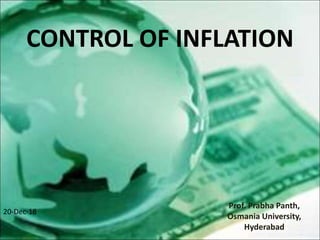
Control of inflation
- 1. CONTROL OF INFLATION Prof. Prabha Panth, Osmania University, Hyderabad 20-Dec-18
- 2. Control of Inflation • Inflation occurs due to mismatch between D and S. • Disequilibrium situation. • Measures to control inflation address: o Reduction in D o Increase in S to correct the disequilibrium • Macro Policy measures include: o Monetary Policy, o Fiscal Policy 2
- 3. 1. Monetary Policy • Monetary Policy: policy of the Central Bank, (RBI) • Acts on Government’s orders. • Controls Supply of money with the public, to reduce D. • Based on Quantity theory of Money. o Supply of money with public falls o Demand for goods fall, o Prices fall, inflation is controlled. 3
- 4. Instruments of Central Bank • Money supply = cash + credit (bank deposits in commercial and central banks) • To reduce money supply with the public, with the commercial banks, and with government. • Two main instruments of credit control 1. Quantitative Measures, 2. Qualitative Measures 4
- 5. 1. Quantitative Measures 1. Bank Rate: • Bank Rate: rate at which CB gives long term credit to commercial banks. No securities needed. o Repo Rate = 8 %. Short term loans by commercial banks from RBI (keeping securities for buy back). o Reverse repo rate= 7%. RBI buys securities from Commercial banks. • During inflation, Bank Rate increases. o Discourages Commercial banks borrowing from CB, o Commercial banks increase own interest rates. o Discourages borrowing by the public, o Encourages savings. 5
- 6. 2. Open Market Operations (OMO): • CB buys and sells shares and securities in the Open Market (Stock Exchange). • During inflation, it sells its own shares and securities in the Open Market. • Commercial banks, other financial companies, and public buy them. • This reduces their cash in hand, and credit, • Fall in money supply D P 6
- 7. 3. Cash Reserve Ratio (CRR): • CB is the Banker’s Bank. • Commercial banks must keep a minimum, at least 3% of their cash deposits with CB. • During inflation, CB increases CRR. (In India CRR = 4.75%) • Cash and credit with Commercial Banks fall. • They reduce their own lending to public. • Fall in money supply D P 7
- 8. Qualitative or Selective Credit Controls 1. Margin Requirements: Entire loan amount is not given to the borrower. • some % of it is retained by the commercial bank. • During inflation, this ratio is increased by CB. • So loan amount actually given is reduced. • Statutory Liquidity Ratio (SLR): minimum % of deposits that commercial banks have to maintain in form of gold, cash or other approved securities. (23% of deposits). 8
- 9. 2. Consumer Credit: loans for buying houses, cars, TV sets, etc is reduced during inflation. Decreases down payments, reduces time for repayment of instalments. 3. Direct Action: against erring banks, who do not follow the CB’s directives. • Will not grant them loans, or help them during exigencies. • Take over or closure of such institutions. • Lesson to others who disobey injunctions. 9
- 10. o Monetised economy and money market, o Higher interest rates luxury goods not affected, pass on higher costs of borrowing to the public. Prices rise. o Investment in Capital formation , growth rate falls. o Small farmers, traders, small and medium scale industries cannot afford higher interest. o Output of essential goods o Supply , prices Impact of Monetary Policy: 10
- 11. Fiscal Policy 1. Reduce Expenditure: Government cuts down unnecessary expenditure. • Reduces pumping more money into the economy. 2. Increase in Direct Taxes: Income, Profit tax, Property tax, to reduce supply of money. 3. Public Borrowing: Removes cash with the public. High interest rates, gilt edged. 11
- 12. Fiscal Policy 4. Increase supply of goods: Government investment, or imports. o In less developed countries, increase in supply more important than controlling demand. o Government investment and encouragement in essential goods production should increase. 5. Control over increase in wages and salaries. 6. Price Controls and rationing. 7. Subsidise essential goods and services. 12
- 13. Growth and Inflation • Developing economies: Economic growth is necessary. • Large scale investments in Heavy, Basic, and Infrastructure. • Long gestation lags (time between Investment and production of output). • Ys and D for necessaries increase, not output. • Prices rise. Such investments called Inflation Creating Activities. 13
- 14. • To reduce rising prices, investment in quick yielding consumer necessaries required. • E.g. in agriculture, small scale production of consumer goods, housing, etc. • Called Inflation Dampening Activities. • Increase in Supply = increase in D for essentials. • When both are in correct proportions (Balanced Allocation Ratio), then inflation can be controlled. 14
- 15. Phillips’s curve • The Phillip’s Curve shows an inverse relationship (trade off) between unemployment and wage inflation. • At full employment, there is competition for labour . • Drives up wage rate. • “Cost Push Inflation”, Ps to maintain profits. • Workers’ real wages will not increase, as P is . • Again demand a rise in nominal wage rates. • More inflation. 15
- 16. The Phillip’s Curve Phillip’s curve Rateofwageinflation% Unemployment rate %0 A 2% B 4% 8% 5% • Unemployment, wage inflation • Or unemployment , inflation 16
- 17. • The Phillip’s curve causes a dilemma to governments. o If it reduces unemployment, leads to inflation. o If it tries to control inflation, unemployment increases. • So some acceptable level of both unemployment and inflation should be found. • Phillip’s curve hypothesis broke down, due to stagflation during the 1970’s. • Stagflation: Stagnation (unemployment) + inflation. o Due to increase in international oil prices, o And Ratchet effect of higher wages. 17
